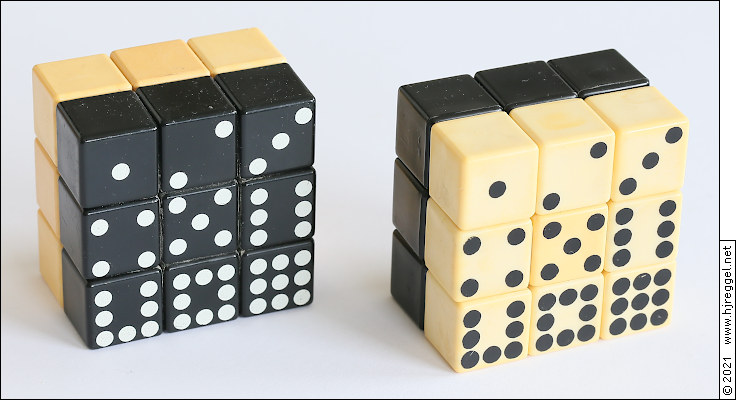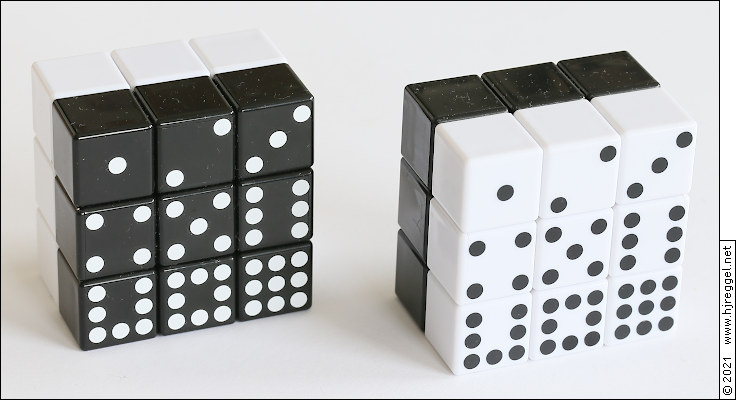 | |
| Two vintage Rubik's Domino, left: black side 1-2-3, right: white side 1-2-3 | |
funCUBING Index Page · funCUBING Projects · The Domino Project
 | |
| Two vintage Rubik's Domino, left: black side 1-2-3, right: white side 1-2-3 | |
The Rubik's Domino was invented by Ernő Rubik, probably in the early 1980s, the patent application is from 1983. Mechanically, it is a 3×3×2 cuboid. The patent application shows two different mechanical implementations. One implementation uses a ridge/groove layout to hold edges, corners and center together, the other implementation uses an axes cross split in half. Both versions have been marketed.
The original name is "Bűvös Dominó" (Magic Domino), similar to the Cube's original name "Bűvös Kocka" (Magic Cube). As a fun fact, all of the original Domino boxes seem to have incorrect vowel marks. The correct marks are ű (long) and ö (short).
Unlike other twisty puzzles, the Domino did not have colored stickers. One half of the Domino is white, the other half is black. This indicates, to which half a cubie belongs. The cubies have Domino tile dots towards the 3×3 top and bottom face, showing numbers 1 to 9. The number 7 on Domino tiles is displayed with seven dots arranged in an "H" Shape, while the number 7 on the Rubik's Domino has the dots arranged in a "U" shape. The dot patterns shown on the original boxes differ from the ones used on the cuboid, except for the USSR versions. There are no marks on the sides, i.e. there are 24 blank cubie faces, and only 18 marked ones.
The colors of the cubies are the only strong indicator of how the cubies should be arranged. Even this leaves room for interpretation: Why not assume a checkerboard layout as correct? The numbers from 1 to 9 invite to put them into an ascending sequence. But what would that be on a 3×3 grid? If you think about that, the numbers are initially only a weak indictor, of how the cubies should be arranged. Since there are no marks on the sides, there is absolutely no indicator how the two halves should be oriented relatve to each other.
The unspoken rule is that the numbers on one side should be arranged from 1 to 9
left to right in lines top to bottom. The other face should show the mirror image when turned around,
or an imaginary blueprint when looking "through" from one side.
If you start on the "wrong" side, you end up with a backward slanted number 2,
a forward slanted number 3, and a "C" shaped number 7.
This 90° rotation could be observed with an "H" shaped number 7 as well,
the reason for the layout is still unknown.
There were many discussions about possible alternative "solutions".
Number 1 is on a corner cubie,
and we can safely assume that this is the start.
Number 2 - as well as all other even numbers - is on an edge cubie.
Because number 5 is on the center cubie,
a clockwise or anticlockwise spiral can be ruled out.
If you start with the number 1 in top left position, you can continue in lines 1-2-3, or columns 1-2-3.
But the 1-2-3 column layout is identical to the mirrored 3-2-1 layout after a 90° turn.
All other combinations right-to-left or bottom-to-top boil down to these two options.
The only variation to this would be a "zig-zag" 1-2-3, 6-5-4, 7-8-9.
But that is only swapping number 4 and number 6, and therefore no significant variant
in terms of complexity.
Putting the number 3 diagonally opposite of number 1 does not produce a sequence of numbers
or any plausible pattern. If you try to solve it as a (chess) knight's tour problem, you get stuck after
eight numbers latest, while already having the number 5 in a corner position.
Having all that said, a person with a strict sense of order will probably agree to the above rules
with
/2 /3 U7.
Solving it into zig-zag or checkerboard is fun, where checkerboard already leaves you with
numbers 2 and 3 being slanted in opposite directions. But the mirror/blueprint condition is kept.
If you want to determine which kind of Domino you have: Put the number seven to the down left position of the 3×3 face. If you read a "C", turn it around, if you read a "U", it's the 1-2-3 side.
Below are some sample arrangements, assuming a "Black" Domino, i.e. black cubie with white dots 7U.
| Default | 1-2-3, 1-2-3 | Reversed | Zig-Zag | Reverse Zig-Zag | Checkerboard | |||||||||||||||||||||||||||||||||||||||||||||||||||||||
| Front (obverse) |
||||||||||||||||||||||||||||||||||||||||||||||||||||||||||||
| Back (reverse) |
||||||||||||||||||||||||||||||||||||||||||||||||||||||||||||
| Mirrored image, projection matches. |
White 2 backwards, black 7U, white 7C. No symmetry, no projection. |
Slant of 2 and 3 different, 7C, mirrored image, projection matches. |
Mirrored image, projection matches. Unusual sequence. |
Slant of 2 and 3 different, 7C, mirrored image, projection matches. |
Slant of 2 and 3 different, mirrored image, projection matches. |
Later, "Domino" has become a term for a 3×3×2 cuboid, either with colored stickers, or as stickerless design. Therefore, some even think that "Domino" would be a special term for cuboids. But actually, these "fake" Domino are simply Rubik's Domino without the dots, and six instead of two colors.
If you want to play with the original concept, but with better turning quality, you have to build one yourself. Actually, the task is very simple: Get a pair of black and white body stickered "modern" Magic Domino from identical mold. Peel off the stickers, mix up the pieces, and attach dots of appropriate size. Nowadays, nobody wants to buy stickered twisty puzzles anymore. Therefore, only very few stickered versions are still available. Finding black and white pairs from identical mold gets more and more complicated with time (I bought the ones shown below back in 2019).
The next question is, what kind of dot pattern to use. If you hold Domino tiles with the number six pattern in upright orientation (as reference orientation from a well-known pattern), there are sets with forward slanted two and three, as well as backward slanted ones. Please note that the slanting does not change upside down, only with 90° rotations. But possible 90° rotations can be ruled out by using the pattern for number six as reference. The seven always seems to be in "H" orientation, not in "Double-T" orientation.
The last question is how to create the dots. The original Rubik's Domino mostly have printed dots. Many Rubik's Domino from the second-hand market have scratches or partially scrubbed dots. The simplest way is to use circular stickers. However, these small stickers tend to come off with excess lubricant, or greasy fingers. Another option is to use stickers with printed dots, or stickers of opposite color with the dots cut out. Both of the latter options look strange.
I prefer forward slanted two and three for the "1-2-3" side, as well as the "U" shaped seven from the Rubik's Domino. The overall image of the 3×3 layout gets a better visual framing. Regarding the stickers, I chose individual dots. They look great, and I can get them in any size and quantity. A good piano player will wash his hands before playing, I try to do the same with my "special" cubes.
 | |
| Reproduction of the Rubik's Domino, left: black side 1-2-3, right: white side 1-2-3 | |
If you like the concept of the Domino Cube, you can take a look at Raising Domino to the Next Level: 3×3×3 Domino Cube .
funCUBING Index Page · funCUBING Projects · The Domino Project · Top of Page